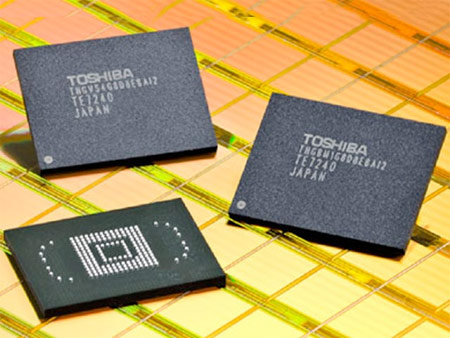Toshiba's Sub-25nm Memory Production To Enable Larger Flash Cards, Drives
Toshiba is currently the world's second largest flash memory producer
behind Samsung, but it's pretty clear that they're looking to take that
top spot over the next few years. Based on a report out of Japan,
Toshiba will be moving towards and even smaller process technology in
the coming years, but the investment will start this year.
During 2010, the company will sink 10-billion Yen (around $160m USD), into a "a test production line for advanced flash memory chips." Toshiba currently products 32nm and 43nm memory chips, but the plan is to begin production on "sub-25nm" chips that could obviously hold a lot more memory onto designs that are the same size as what we use today. In theory, a sub-25nm memory chip would be able to shove more memory onto an SDHC card than what we can today, simply because of the density increase.

According to those reports, Toshiba could output NAND chips with "circuitry widths in the upper 20 nanometre range soon, while production of chips with circuitry widths in the lower 20 nanometres is slated to start as early as 2012." A spokesperson for the company also said that Toshiba plans to begin "commercial production of NAND flash memory chips with circuitry widths somewhere between 20 and 29 nanometres in the second half of 2010, but it has not been decided whether the circuitry will be wider or narrower than 25 nanometres."
Getting the density down is key to expanding on memory; if you want larger SSDs, SDHC cards and DIMM sticks, you want these nanometers to shrink. This also allows more storage to be planted into smaller devices (smartphones, for example), where space comes at a premium. Furthermore, it drives down prices of existing sizes, which is music to any consumer ear.
During 2010, the company will sink 10-billion Yen (around $160m USD), into a "a test production line for advanced flash memory chips." Toshiba currently products 32nm and 43nm memory chips, but the plan is to begin production on "sub-25nm" chips that could obviously hold a lot more memory onto designs that are the same size as what we use today. In theory, a sub-25nm memory chip would be able to shove more memory onto an SDHC card than what we can today, simply because of the density increase.

According to those reports, Toshiba could output NAND chips with "circuitry widths in the upper 20 nanometre range soon, while production of chips with circuitry widths in the lower 20 nanometres is slated to start as early as 2012." A spokesperson for the company also said that Toshiba plans to begin "commercial production of NAND flash memory chips with circuitry widths somewhere between 20 and 29 nanometres in the second half of 2010, but it has not been decided whether the circuitry will be wider or narrower than 25 nanometres."
Getting the density down is key to expanding on memory; if you want larger SSDs, SDHC cards and DIMM sticks, you want these nanometers to shrink. This also allows more storage to be planted into smaller devices (smartphones, for example), where space comes at a premium. Furthermore, it drives down prices of existing sizes, which is music to any consumer ear.

